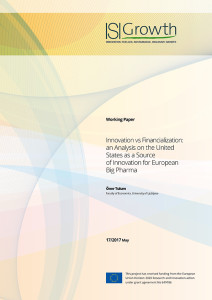Driven by the perspective of maximizing shareholder value (MSV), the U.S. biopharmaceutical industry has adopted a highly financialized business model. In such a model, the key metrics are stock-price performance, earnings per share, and dividend yield, supported by distributions to shareholders in the forms of dividends and stock buybacks. Such value extraction is incentivized by stock-based executive pay and can be pursued at the expense of productivity in drug innovation (Lazonick et al. 2017). Yet with government support for drug development through the National Institutes of Health and various forms of intellectual property protection and government financial subsidies as well as unregulated drug prices that can provide high profits for reinvestment in drug development, the U.S. prescription drug market should be highly conducive to innovation in drug development (Lazonick and Tulum 2011). This paper asks whether less-financialized European pharma companies, which are subject to price regulation in their home markets, can make use of U.S. business conditions to engage in innovation by tapping into the immense knowledge base in the United States and selling their products in the United States at high, unregulated, prices. Making use of Lazonick’s social conditions of innovative enterprise framework, the analytical approach employed in this research inquiry is twofold. First, the sources of innovative capabilities within the top seven European pharma companies are examined. Second, for the purpose of this particular paper, the top innovation performer among the seven companies is identified for a firm- level case analysis to explore how a non-financialized company can make better use than financialized companies of capabilities and incentives available in the US drug market to achieve greater productivity. As the top performers in the US drug market, Novartis, Hoffmann-La Roche, GlaxoSmithKline, AstraZeneca, Bayer, Merck KGaA, and Sanofi-Aventis are selected for product analysis. The analysis reveals the geographic origins of pharma products and geographic sources of pharma revenues of these European companies. Identified as the top performer by various different productivity attributes, the case-analysis of Swiss-based Roche (Hoffman-La Roche) explains how a non-financialized outsider to a national economy can gain competitive advantage by operating in that economy in ways that financialized insiders, undermined by MSV, cannot.
Innovation vs Financialization: an Analysis on the United States as a Source of Innovation for European Big Pharma
Öner Tulum
Faculty of Economics, University of Ljubljana

